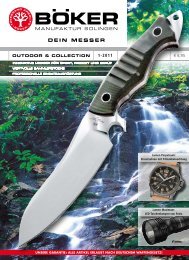Boker Knifestyle | Edition 2020 / 2021 | English
You also want an ePaper? Increase the reach of your titles
YUMPU automatically turns print PDFs into web optimized ePapers that Google loves.
BOKER DAMASCUS<br />
07<br />
DAMASCUS STEEL<br />
A thousands-of-years old blacksmithing craft that<br />
still unfolds its fascination today. Originally, forging<br />
multilayered steel was supposed to produce the<br />
best possible quality material. Today, Damascus<br />
enthusiasts hardly care about the technical aspect<br />
anymore. They are passionate about the fascinating<br />
material and its special look.<br />
Classic handforged Damascus steel consists of at<br />
least two types of steel with different compositions.<br />
After forging, the piece of steel is folded and<br />
forged again, which doubles the number of layers.<br />
The process is repeated until the desired number of<br />
layers is reached. By using steel types with different<br />
properties, the blacksmith can influence the quality<br />
of the Damascus significantly; a particularly hard<br />
steel, for instance, can be combined with an<br />
especially resilient steel in order to achieve a<br />
balanced ratio of hardness and edge retention.<br />
The Damascus pattern is influenced by forging and<br />
the number of layers, but it can also be created by<br />
embossing the finished forged Damascus bar. By<br />
embossing the bar with the help of an embossing<br />
punch with a specific pattern, the layers within the<br />
Damascus shift against each other. The embossed<br />
pattern appears as texture in the Damascus steel<br />
once the embossed material is ground into a blade.<br />
The pattern is barely visible on a freshly ground<br />
blade. It needs to be finished in a special acid bath,<br />
in which both types of steel react to the acid by<br />
darkening at different levels. This brings out the<br />
pattern created by the texture and reveals the true<br />
magnificent beauty of Damascus steel.<br />
Contrary to classic Damascus production,<br />
stainless steel cannot be forged together under<br />
normal circumstances. However, clever Damascus<br />
blacksmiths came up with a technique that<br />
circumvents this obstacle. The essential factor is<br />
oxygen.<br />
While classic, non-stainless Damascus is forged<br />
and folded in a regular open smithy, the ambient<br />
air is the deciding factor for stainless Damascus –<br />
it prevents stainless steel layers from being forged<br />
together. Hence, stainless Damascus is made by<br />
preparing layer packages and forging them in a<br />
vacuum.<br />
One of the most sophisticated methods for forging<br />
Damascus steel is torsion Damascus. Here, a twist<br />
is added to the classic folding of the material. This<br />
creates a unique pattern and the control needed<br />
to master this forging process requires the highest<br />
level of expertise.<br />
Torsion Damascus was found in the few preserved<br />
Vikings swords, made at a time when the most<br />
sophisticated pieces were forged with outstanding<br />
skill and craftsmanship far superior to the standard<br />
swords of the day, even in technical terms.<br />
The highly complex forging process that creates<br />
the characteristic pattern makes torsion Damascus<br />
one of the rarest and most exclusive types of<br />
Damascus steel.


















